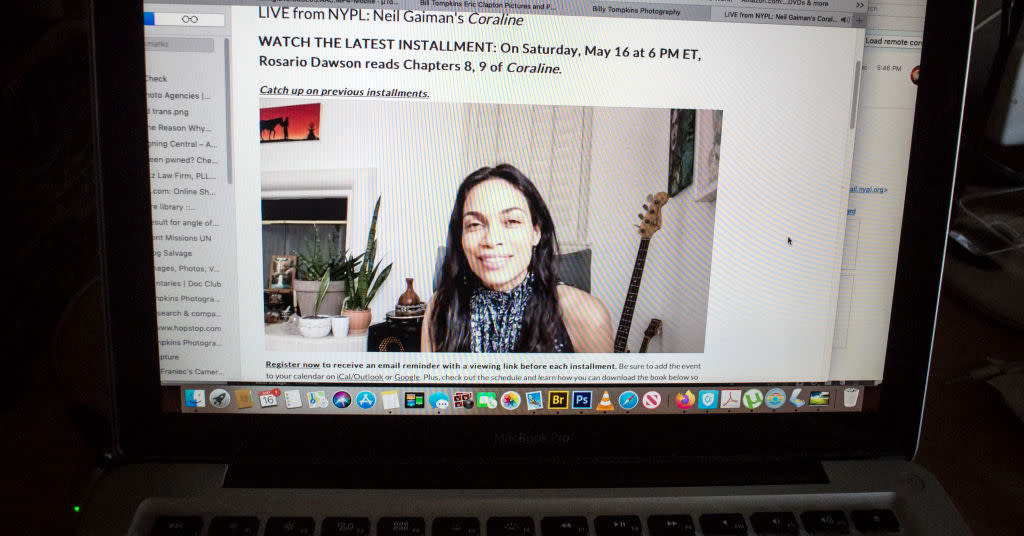The future of libraries already looked increasingly digital, then came the coronavirus

Even before they shut down because of the coronavirus, libraries were offering more digital content, such as ebooks and audiobooks. Then it quickly became their primary way of reaching the public.
It’s a change that Ramiro S. Salazar, director of the San Antonio Public Library System, expects to be permanent.
“Before the pandemic, the demand for print or physical items was like 5 to 1 compared to digital, ebooks and digital magazines and downloadable audio books as well,” Salazar, who’s also president of the Public Library Association, tells Yahoo Entertainment. “I think that’s going to change behaviors in the long run.”
San Antonio libraries are offering storytime recordings online, something they’ve never done before. The staff’s produced significant podcast content for the first time, and they’re marking the central library’s 25th birthday with the “first-ever virtual celebration” on May 23. This is all in addition to some other programs they shared online, such as a tutorial on making face masks and a book festival for kids and teens.
Join us for an informative step-by-step cloth mask making tutorial and demonstration using free patterns from https://t.co/ytOhx6DPxV! The fun starts TONIGHT at 7 p.m. 🕖 Don't miss it!https://t.co/GKFHFDLnUZ pic.twitter.com/bvFYcbJqv1
— mysapl (@mysapl) May 14, 2020
Anthony W. Marx, president of the New York Public Library, says they’ve seen an increase of 864 percent in the number of people signing up for digital library cards since their temporary closure on March 14. The number of new users across all its e-reading platforms has increased about 200 percent.
“We expect those gains to continue even after we reopen, as our patrons adjust to their new normal,” Marx says. “So we will need to continue to improve and expand those offerings.”
Marx says the staff is evaluating a virtual model for programs and classes, because they realize it could be a while before they’re able to offer them in person again. They’re already doing an online storytime and author talks, like a conversation this week between Cleopatra scribe Stacy Schiff and Making the Cut star Tim Gunn, and they plan to offer more. LeVar Burton, Rosario Dawson, Dakota Fanning and author Neil Gaiman read his novella Coraline during a six-day event this month.
“As patrons become more accustomed to virtual services, the demand will increase, so the reality is this is going to be a much bigger part of how we operate moving forward,” Marx says. “Our physical services and community spaces will always be an important aspect of the library, but we need to expand what we’re doing virtually.”
Tired of using your wall as your video conference backdrop? Visit NYPL (virtually) for your next video call. https://t.co/C0NvIz708C
— NY Public Library (@nypl) May 20, 2020
Both Marx and Salazar mention the importance of bridging the digital divide — the growing gap between people who have access to the internet and people who don’t — when talking about the library of the future.
They loan out hotspots with WiFi access in New York City. In San Antonio, Salazar says his team is in the process of equipping their outreach vehicles with the same devices, so they can drive them out to communities where people need more internet.
It’s not clear when people who use libraries for their entertainment needs — the institution’s immeasurable assistance to the homeless and those who seek an education there is a whole other story — will be back to browsing the physical shelves. The whole idea of moving around the world without fear or stress, say by picking up various books and then placing them back on a shelf, seems very 2019.
Some libraries are offering curbside service, where people select books online and pick them up in front of the building. Even that plan presents issues: Marx has discussed the possibility of needing to quarantine books once they’ve been returned, depending on what scientists learn about COVID-19.
Not to mention that libraries will most certainly be squeezed from less funding due to the cratering economy.
So, yes, they’ll most certainly look different than we remember once they reopen but it doesn’t have to be a bad different.
“What I have done,” Salazar says, “is challenge our team to be thinking of how we will be reinventing ourselves as a public institution.”
For the latest coronavirus news and updates, follow along at https://news.yahoo.com/coronavirus. According to experts, people over 60 and those who are immunocompromised continue to be the most at risk. If you have questions, please reference the CDC’s and WHO’s resource guides.
How to maintain your physical and mental health during the pandemic
Taking care of a loved one with COVID-19? Here’s how to stay healthy
Q&A with Dr. Kavita Patel: How to keep your family safe and maintain your mental health
Read more from Yahoo Entertainment:




